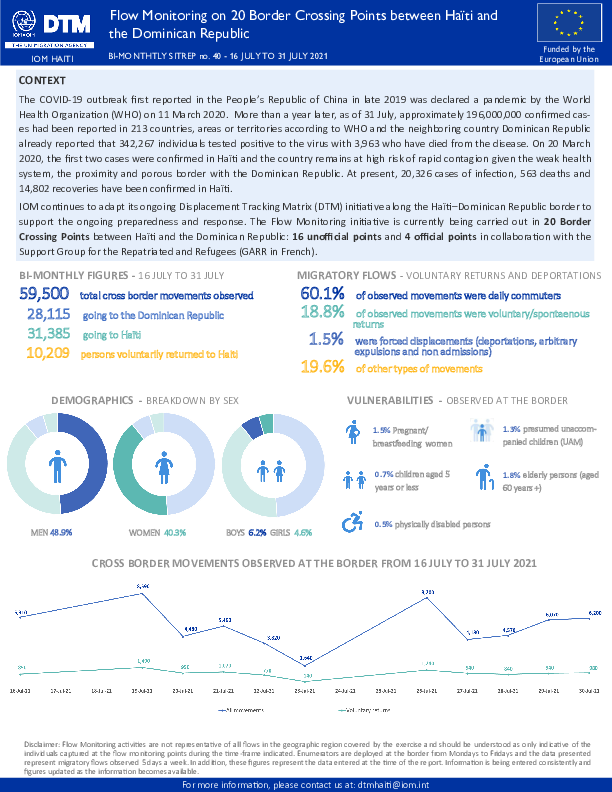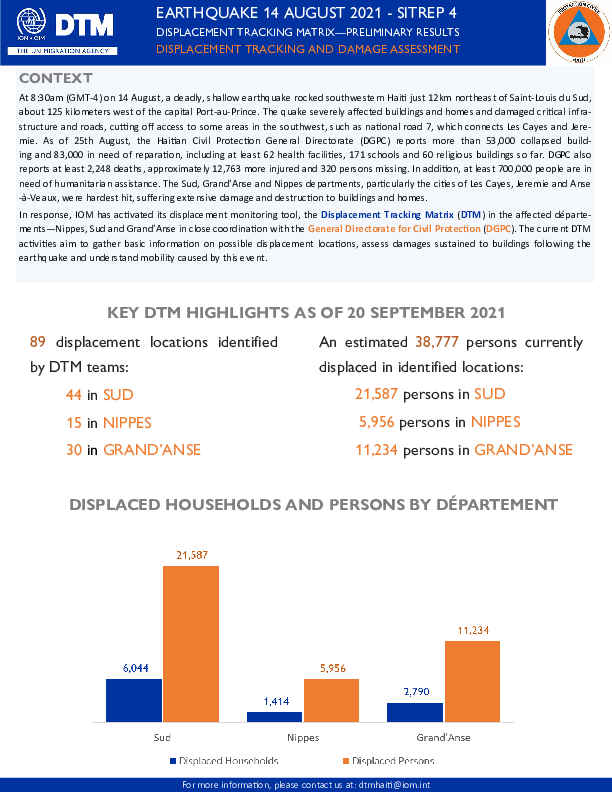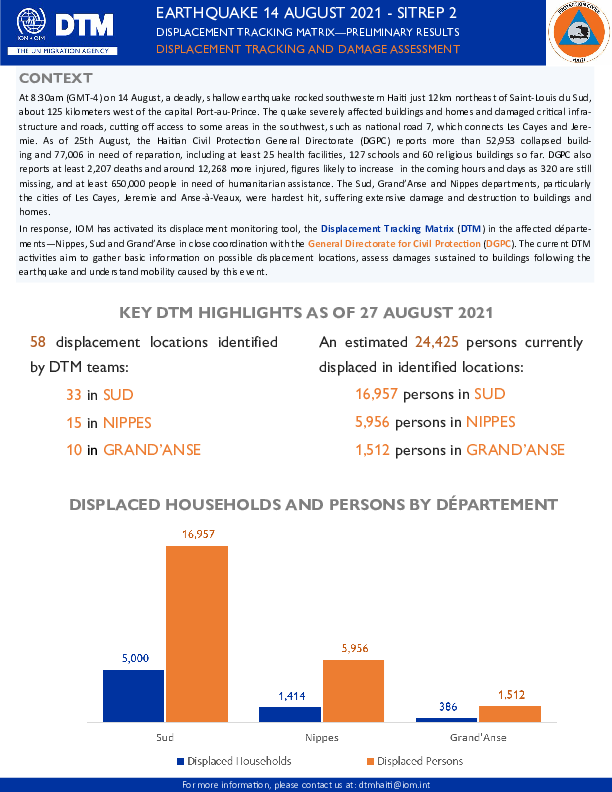-
Countries
-
Data and Analysis
-
Special Focus
-
Crisis Responses

Contact
dtmhaiti@iom.int
Language
English
Location
Haiti
Period Covered
Jul 16 2021
Jul 31 2021
Activity
- Flow Monitoring
The COVID-19 outbreak first reported in the People’s Republic of China in late 2019 was declared a pandemic by the World Health Organization (WHO) on 11 March 2020. More than a year later, as of 31 July, approximately 196,000,000 confirmed cases had been reported in 213 countries, areas or territories according to WHO and the neighboring country Dominican Republic already reported that 342,267 individuals tested positive to the virus with 3,963 who have died from the disease. On 20 March 2020, the first two cases were confirmed in Haïti and the country remains at high risk of rapid contagion given the weak health system, the proximity and porous border with the Dominican Republic. At present, 20,326 cases of infection, 563 deaths and 14,802 recoveries have been confirmed in Haïti.

Contact
dtmhaiti@iom.int
Language
English
Location
Haiti
Period Covered
Aug 01 2021
Aug 15 2021
Activity
- Flow Monitoring
The COVID-19 outbreak first reported in the People’s Republic of China in late 2019 was declared a pandemic by the World Health Organization (WHO) on 11 March 2020. More than a year later, as of 15 August, approximately 205,000,000 confirmed cases had been reported in 213 countries, areas or territories according to WHO and the neighboring country Dominican Republic already reported that 346,459 individuals tested positive to the virus with 3,985 who have died from the disease. On 20 March 2020, the first two cases were confirmed in Haïti and the country remains at high risk of rapid contagion given the weak health system, the proximity and porous border with the Dominican Republic. At present, 20,732 cases of infection, 583 deaths and 16,866 recoveries have been confirmed in Haïti.

Contact
DTM Haiti, DTMHaiti@iom.int
Language
English
Location
Haiti
Snapshot Date
Sep 03 2021
Activity
- Mobility Tracking
At 8:30am (GMT-4) on 14 August, a deadly, shallow earthquake rocked southwestern Haiti just 12km northeast of Saint-Louis du Sud, about 125 kilometers west of the capital Port-au-Prince. The quake severely affected buildings and homes and damaged critical infrastructure and roads, cutting off access to some areas in the southwest, such as national road 7, which connects Les Cayes and Jeremie. As of 25th August, the Haitian Civil Protection General Directorate (DGPC) reports more than 52,953 collapsed building and 77,006 in need of reparation, including at least 25 health facilities, 127 schools and 60 religious buildings so far. DGPC also reports at least 2,207 deaths, approximately 12,268 more injured and 320 persons missing. In addition, at least 650,000 people are in need of humanitarian assistance. The Sud, Grand'Anse and Nippes departments, particularly the cities of Les Cayes, Jeremie and Anse-a-Veaux, were hardest hit, suffering extensive damage and destruction to buildings and homes.
In response, IOM has activated its displacement monitoring tool, the Displacement Tracking Matrix (DTM) in the affected départements – Nippes, Sud and Grand’Anse – in close coordination with the General Directorate for Civil Protection (DGCP). The current DTM activities aim to gather basic information on possible displacement locations, assess damages sustained to buildings following the earthquake and understand mobility caused by this event.
IOM works with national and local authorities in order to gain a better understanding of population movements throughout Southern Africa. Through the setup of Flow Monitoring Points (FMPs), IOM seeks to quantify migration flows, trends and routes and to gain a better understanding of the profiles of observed individuals at entry, transit or exit points (such as border crossing posts, bus stations, rest areas, police checkpoints and reception centres). This report is an overview of the data collected in these FMPs from 1 to 31 March 2022.
Inter-regional migration from and within the Southern Africa is categorized along the following corridors. The Flow Monitoring Points (FMPs) were set-up in several key transit locations along the corridors to track the movements of passengers:
•Zimbabwe (Mutare) – Mozambique (Manica)
•Zimbabwe – Zambia (Chirundu)
•Zimbabwe – Botswana (Plumtree)
•Zimbabwe (Beitbridge) – South Africa
•Malawi (Mchinji) - Zambia (Mwami)
•Malawi (Karonga ) – United Republic of Tanzania
•Malawi (Mwanza) – Mozambique (Zobue)
•Malawi (Mulanje) – Mozambique
•Mozambique (Ressano Garcia) – South Africa
Over the reporting period a total of 72,637 movements were observed across 45 FMPs in the region. The Zimbabwe – South Africa corridor hosted the largest number of movements with 49,483 (68%) followed by the Malawi (Mwanza) – Mozambique (Zobue) corridor with 7,783 (11%) and the Zimbabwe – Zambia corridor with 4,369 movements reported (6%).

Contact
DTM Haiti, DTMHaiti@iom.int
Language
English
Location
Haiti
Snapshot Date
Sep 20 2021
Activity
- Mobility Tracking
At 8:30am (GMT-4) on 14 August, a deadly, shallow earthquake rocked southwestern Haiti just 12km northeast of Saint-Louis du Sud, about 125 kilometers west of the capital Port-au-Prince. The quake severely affected buildings and homes and damaged critical infrastructure and roads, cutting off access to some areas in the southwest, such as national road 7, which connects Les Cayes and Jeremie. As of 25th August, the Haitian Civil Protection General Directorate (DGPC) reports more than 53,000 collapsed building and 83,000 in need of reparation, including at least 62 health facilities, 171 schools and 60 religious buildings so far. DGPC also reports at least 2,248 deaths, approximately 12,763 more injured and 320 persons missing. In addition, at least 700,000 people are in need of humanitarian assistance. The Sud, Grand'Anse and Nippes departments, particularly the cities of Les Cayes, Jeremie and Anse-a-Veaux, were hardest hit, suffering extensive damage and destruction to buildings and homes.
In response, IOM has activated its displacement monitoring tool, the Displacement Tracking Matrix (DTM) in the affected départements – Nippes, Sud and Grand’Anse – in close coordination with the General Directorate for Civil Protection (DGCP). The current DTM activities aim to gather basic information on possible displacement locations, assess damages sustained to buildings following the earthquake and understand mobility caused by this event.

Contact
RO Dakar, RODakar-DataResearch@iom.int
Language
French
Location
Senegal
Period Covered
Jan 01 2022
Feb 28 2022
Activity
- Other
- Flow Monitoring
L'Outil de suivi des zones de départ surveille les événements liés aux mouvements migratoires des côtes du Sénégal vers les îles Canaries espagnols (qui, le plus souvent, se déroulent à travers plusieurs étapes intermédiaires), dans le but de documenter la mobilité le long de la route atlantique ouest-africaine (WAAR). Ce rapport présente les données collectées par l'outil de suivi des départs entre le 1er janvier et le 28 février 2022 aux principaux points de départ le long du littoral sénégalais. Les informations sont fournies aux agents recenseurs par les Points Focaux Communautaires (PFC) qui fournissent des informations sur les événements notables observés dans les zones de départ utilisées par les migrants pour se rendre en Mauritanie, au Maroc et aux îles Canaries.

Contact
DTM Haiti, DTMHaiti@iom.int
Language
English
Location
Haiti
Snapshot Date
Aug 27 2021
Activity
- Mobility Tracking
At 8:30am (GMT-4) on 14 August, a deadly, shallow earthquake rocked southwestern Haiti just 12km northeast of Saint-Louis du Sud, about 125 kilometers west of the capital Port-au-Prince. The quake severely affected buildings and homes and damaged critical infrastructure and roads, cutting off access to some areas in the southwest, such as national road 7, which connects Les Cayes and Jeremie. As of 25th August, the Haitian Civil Protection General Directorate (DGPC) reports more than 52,953 collapsed building and 77,006 in need of reparation, including at least 25 health facilities, 127 schools and 60 religious buildings so far. DGPC also reports at least 2,207 deaths and around 12,268 more injured, figures likely to increase in the coming hours and days as 320 are still missing, and at least 650,000 people in need of humanitarian assistance. The Sud, Grand'Anse and Nippes departments, particularly the cities of Les Cayes, Jeremie and Anse-a-Veaux, were hardest hit, suffering extensive damage and destruction to buildings and homes.
In response, IOM has activated its displacement monitoring tool, the Displacement Tracking Matrix (DTM) in the affected départements – Nippes, Sud and Grand’Anse – in close coordination with the General Directorate for Civil Protection (DGCP). The current DTM activities aim to gather basic information on possible displacement locations, assess damages sustained to buildings following the earthquake and understand mobility caused by this event.

Contact
DTM Cameroon, DTMCameroun@iom.int
Language
French
Location
Cameroon
Period Covered
Apr 05 2022
Apr 18 2022
Activity
- Event Tracking
- Mobility Tracking
L’objectif de l’outil de suivi des urgences est de rassembler des informations sur les mouvements significatifs et soudains de populations. Ce tableau de bord présente des informations sur des mouvements de déplacement survenus entre le 5 et 18 avril 2022 dans 4 localités du département du Mayo-Tsanaga région de l’Extrême-Nord).

Contact
DTMcovid19@iom.int
Language
English
Location
Global
Snapshot Date
Apr 11 2022
Activity
- Other
The DTM Global Mobility Restrictions Overview provides updates on international air travel restrictions and conditions for
authorized entry. This overview aims to understand how COVID-19 has impacted human mobility, detailing how global
and regional trends in air travel measures have evolved since COVID-19 was declared a global pandemic in March 2020.
The data presented focuses on the changes in public health-related immigration and border management measures. It
provides information intended to support IOM missions and partners in targeted response planning and advocacy for
vulnerable populations who may be affected by changes in global mobility.

Contact
DTMMozambique@iom.int
Language
English
Location
Mozambique
Period Covered
Apr 06 2022
Apr 12 2022
Activity
- Event Tracking
- Mobility Tracking
During the reporting period (06 to 12 April 2022), a total of 38 movements were recorded - 7 returns (2,591 individuals), 26 arrivals (1,187 individuals), 2 transits (65 individuals) and 3 departures (17 individuals). The largest return movements were recorded in Muidumbe (2,279 individuals) and Montepuez (312 individuals). The largest arrival movements were recorded in Nangade (539 individuals), Muidumbe (202 individuals), Montepuez (191 individuals), and Meluco (180 individuals). The largest departure was observed in Chiure (11 individuals). The largest transit movement was observed in Mueda (41 individuals). Of the total population, 36 per cent of the mobile groups were displaced for the first time, and 64 per cent of reported to having been displaced more than once prior to this movement.

